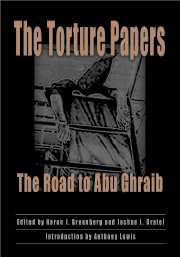Book contents
- Frontmatter
- Contents
- Acknowledgments
- Introduction
- From Fear to Torture
- The Legal Narrative
- Timeline
- Missing Documents
- Biographical Sketches
- Memoranda
- Reports
- February 2004 (The ICRC Report)
- March 2004 (The Taguba Report)
- April 2004
- July 2004 (The Mikolashek Report)
- August 2004 (The Schlesinger Report)
- May 12, 2004 (Vice Admiral Church's Brief)
- October 2004 (Department of Defense Response to the Associated Press)
- August 2004 (The Fay-Jones Report)
- August 9, 2004
- Afterword
- Appendices
August 2004 (The Fay-Jones Report)
from Reports
Published online by Cambridge University Press: 05 June 2012
- Frontmatter
- Contents
- Acknowledgments
- Introduction
- From Fear to Torture
- The Legal Narrative
- Timeline
- Missing Documents
- Biographical Sketches
- Memoranda
- Reports
- February 2004 (The ICRC Report)
- March 2004 (The Taguba Report)
- April 2004
- July 2004 (The Mikolashek Report)
- August 2004 (The Schlesinger Report)
- May 12, 2004 (Vice Admiral Church's Brief)
- October 2004 (Department of Defense Response to the Associated Press)
- August 2004 (The Fay-Jones Report)
- August 9, 2004
- Afterword
- Appendices
Summary
EXECUTIVE SUMMARY
Investigation of Intelligence Activities At Abu Ghraib
Background
This investigation was ordered initially by LTG Ricardo S. Sanchez, Commander, Combined Joint Task Force Seven (CJTF-7). LTG Sanchez appointed MG George R. Fay as investigating officer under the provisions of Army Regulation 381-10, Procedure 15. MG Fay was appointed to investigate allegations that members of the 205th Military Intelligence Brigade (205 MI BDE) were involved in detainee abuse at the Abu Ghraib Detention Facility. Specifically,MG Fay was to determine whether 205 MI BDE personnel requested, encouraged, condoned, or solicited Military Police (MP) personnel to abuse detainees and whether MI personnel comported with established interrogation procedures and applicable laws and regulations.
On 16 June 2004, Acting Secretary of the Army R. L. Brownlee appointed General Paul J. Kern, Commander, US Army Material Command (AMC), as the new Procedure 15 appointing authority. On 25 June 2004, GEN Kern appointed LTG Anthony R. Jones, Deputy Commanding General, US Army Training and Doctrine Command, as an additional Procedure 15 investigating officer. MG Fay was retained as an investigating officer.
Without reinvestigating areas reviewed by MG Fay, LTG Jones was specifically directed to focus on whether organizations or personnel higher than the 205th MI BDE chain of command, or events and circumstances outside of the 205th MI Brigade, were involved, directly or indirectly, in the questionable activities regarding alleged detainee abuse at Abu Ghraib prison.
- Type
- Chapter
- Information
- The Torture PapersThe Road to Abu Ghraib, pp. 987 - 1131Publisher: Cambridge University PressPrint publication year: 2005
- 1
- Cited by



